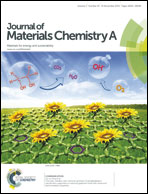The templating effect of an easily available cationic polymer with widely separated charge centers on the synthesis of a hierarchical ZSM-5 zeolite†
Abstract
The epichlorohydrin-N,N-dimethyl-1,3-diaminopropane copolymer (PCA) has been introduced for the first time as a meso-template to successfully synthesize a hierarchical ZSM-5 zeolite (PCA-ZSM-5) with mesopores of 7–50 nm in diameter by using small-sized nanoblocks. However, when its structural analogue epichlorohydrin–dimethylamine polyamine (PCS) is used, the obtained ZSM-5 zeolite (PCS-ZSM-5) has lower mesoporosity than ZSM-5 nanocrystallite aggregates (NCA-ZSM-5) synthesized without the meso-template. The templating effect of the two employed cationic polymers (PCS and PCA) on the synthesis of hierarchical ZSM-5 is valuable and interesting to be evaluated, because they are easily available and have common structural characteristics that their macromolecular structure will be largely endangered by the decomposition of quaternary ammonium groups in the long polymer chain. PCA entrapped in the zeolite partially retains its cationic charges and macromolecular structure under hydrothermal conditions and thus has a significant templating effect on the synthesis of hierarchical ZSM-5, which is benefited from the cationic centers widely separated by more than 3 carbons in PCA. However, PCS decomposes severely into small amine molecules, due to the short separation of cationic centers. Further investigation into the templating effect of PCA shows that the small-sized and negatively charged nanoblocks can easily wrap and assemble with PCA and transform into hierarchical ZSM-5 templated by PCA. However, when using large-sized zeolite seeds to synthesize ZSM-5, PCA shows a negligible templating effect because PCA with limited charge density and low accessibility of cationic charges has insufficient interactions with zeolite seeds. The catalytic activities of PCA-ZSM-5 and NCA-ZSM-5 for acetalization of cyclohexanone with methanol are inferior to that of PCS-ZSM-5 with the highest number of acid sites, but the catalytic activities for aldol condensation of benzaldehyde with n-butyl alcohol follow the order of PCA-ZSM-5 > NCA-ZSM-5 > PCS-ZSM-5, consistent with the order of mesoporosity.


 Please wait while we load your content...
Please wait while we load your content...